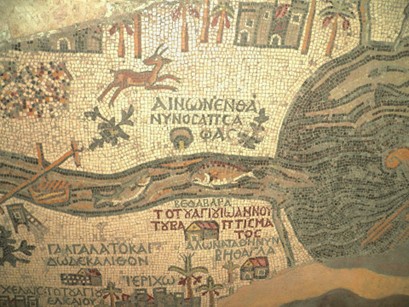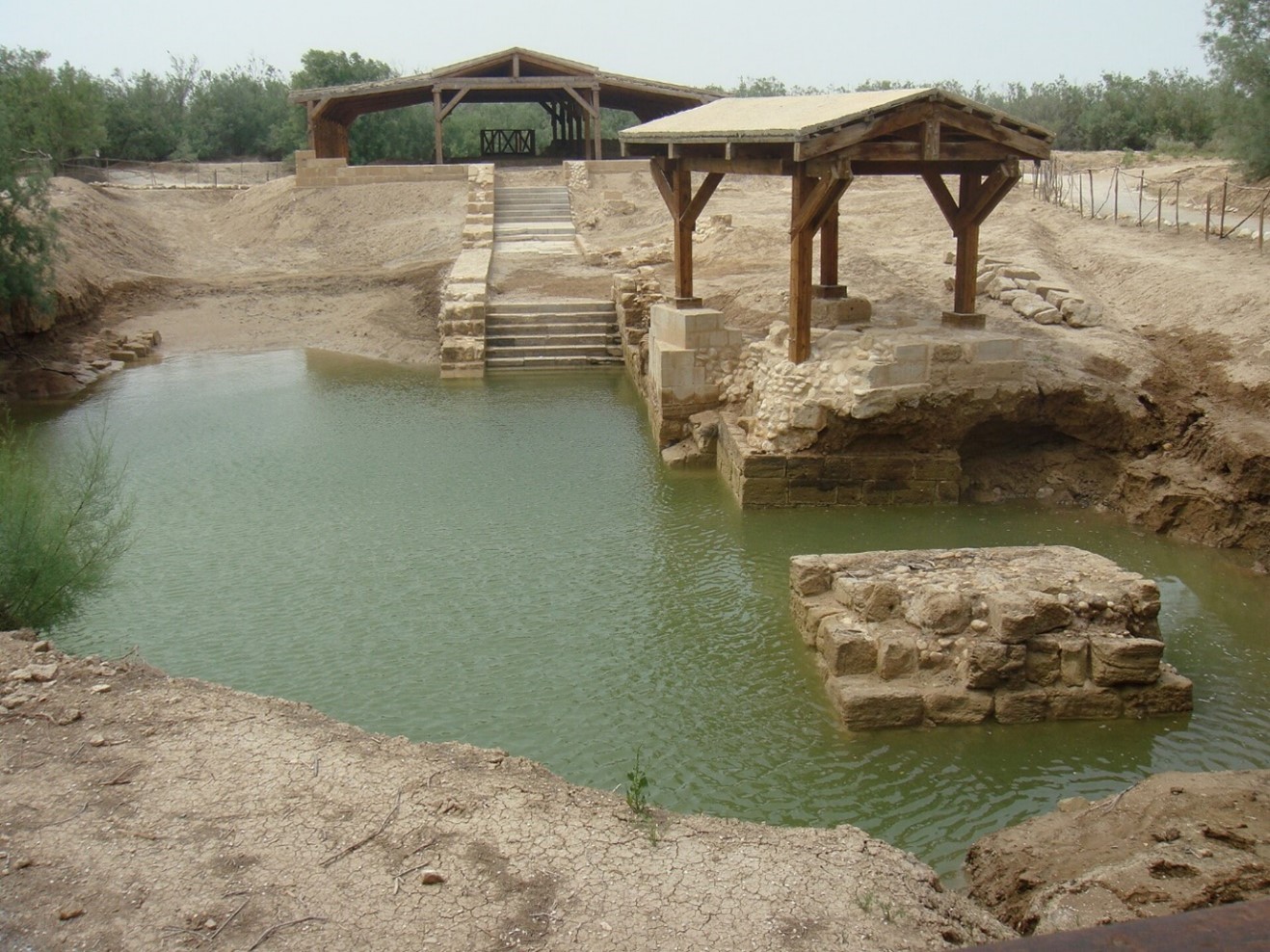
The section of the lower Jordan valley on the Madaba Map
https://en.wikipedia.org/wiki/Madaba_Map#/media/File:Sapsaphas_Madaba.jpg
A-Z of Places Jesus Visited

The section of the lower Jordan valley on the Madaba Map
https://en.wikipedia.org/wiki/Madaba_Map#/media/File:Sapsaphas_Madaba.jpg
These things were done in Bethabara beyond Jordan, where John was baptizing.
John 1v28
In the country of Jordan, around 20 miles south of the capital Amman, built into a church floor, is the oldest surviving map of the Holy Land. The Madaba map is a 6th century mosaic with locations from Galilee to Egypt marked in Greek. Although there are gaps in the map, the lower Jordan valley and Jerusalem is particularly clear. The word Bethabara1 can be made out on the map as the place just before the Jordan river flows into the Dead Sea.
The name Bethabara means ‘house of crossing’ or ‘house of ford’. The apostle John, identifies it in his gospel as the location where John the Baptist was baptising as the Lord Jesus was about to commence His public ministry at about 30 years of age.2 Specifically, we are told that it was Bethabara ‘beyond Jordan’, on the east bank of the river, on the opposite side to Jerusalem. Fed from the high Jordan plateau, clear freshwater streams join the dirty silt-rich waters of the Jordan River. These clean waters would have been an ideal place to carry out baptisms.
The area was rich in history for Israel; it was the place of beginnings. At this section of the River Jordan adjacent to Jericho3 was where Israel entered into the Promised Land; crossing through on dry land, after 40 years of wandering in the wilderness.4 Later, the great prophet Elijah came to this place prior to his departure from this earth. It was from here Elijah was taken up to heaven in an angelic chariot of fire.5
John the Baptist was a remarkable individual. People who came to visit him must have been startled at his appearance6 and also his direct and austere ministry. However, the Lord Jesus said of John, ‘verily I say unto you, among them that are born of women there hath not risen a greater than John the Baptist’.7 People even wondered whether John may have indeed been the Christ; the long promised anointed One whom God had told Israel would arrive one day. John confessed ‘I am not the Christ’.8 Who was he then, if not the Christ or a reincarnated Elijah? John’s answer was simple. He was ‘the voice of One crying in the wilderness’.9 Only an unseen voice, with all attention directed towards another.
As we read John chapter 1, we find John the Baptist, this greatest of prophets, about to utter his greatest message. It was indeed the culminating event of his life’s ministry. In verse 29 we read John’s monumental declaration: ‘the next day John seeth Jesus coming unto him, and saith, Behold the Lamb of God, which taketh away the sin of the world’. John had recently received positive confirmation of who the Lord Jesus was as He came to John to be baptised. A voice from heaven had declared in regard to the Lord Jesus, ‘this is My beloved Son in whom I am well pleased’. And all present had also witnessed the Holy Spirit descending on Him like a dove.10

The area thought to be Bethabara where John the Baptist preached and baptised. It is probably the place where the Lord Jesus was baptised.
https://en.wikipedia.org/wiki/Al-Maghtas#/media/File:Bethany_(5).JPG
The words of John ring down through the ages and speak clearly today. They exhort us to ‘behold’, to give our attention to the most important person in history. God’s only begotten Son, the Lord Jesus Christ; the greatest gift that God has bestowed on this world. Yet He came to be ‘the Lamb of God’. The idea of a sacrificial lamb was central to the life of Israel. Each year began with remembering their liberation from slavery in the land of Egypt; when each family had taken an innocent lamb and killed it, applying its blood to the doorposts and lintel of their house. Doing so had ensured their security.
Here, John the Baptist was reminding us that this story was a picture of something much greater. The human race has been enslaved by sin. Our turning away from God has oppressed us and removed our freedom. The Lord Jesus came to take away, not only the individual acts of disobedience we have all committed against God, but the very principle of sin itself. On the cross, the Lord Jesus destroyed, root and branch, the slavery caused by sin.
Bethabara was a place of cleansing. Yet no amount of church-going or doing good or baptising can cleanse us from our sins. Only one thing can do that. The Bible says, ‘the blood of Jesus Christ his Son cleanseth us from all sin’, 1 John 1 v7. Through trusting Jesus Christ as our risen Lord, and accepting the infinite value of His precious blood shed for us on the cross, we too can be cleansed once and for all from our sins, past, present and future. The point at which we trust Him, our sins are taken away and we are as ready for heaven as we will ever be. The Lord Jesus is definitely someone who warrants our attention and like John, we also draw attention to Him for your consideration.
2 John 1 v28
3 See the Greek word ΙЄΡΙΧω on the map
4 Joshua 3 v1 – 4v24
5 2Kings 2 v1-14
6 Mark 1 v6
7 Matthew 11 v11
8 John 1 v20
9 John 1 v23 was a quotation of John of the words of Isaiah 40 v3 written over 700 years earlier.
10 Matthew 3 v13-17